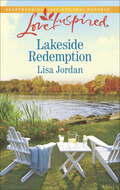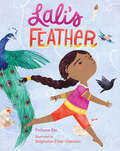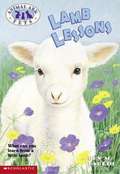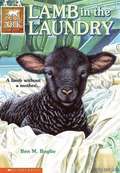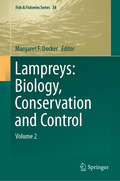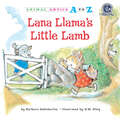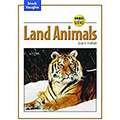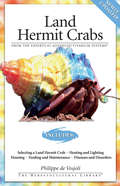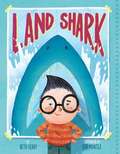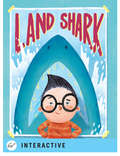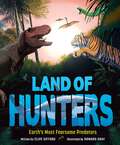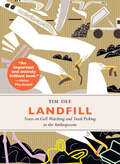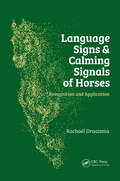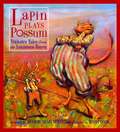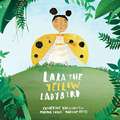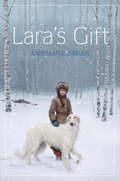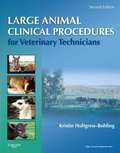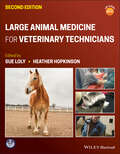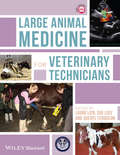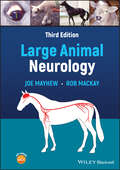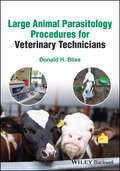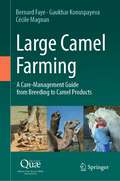- Table View
- List View
Lakeside Redemption
by Lisa JordanFresh Start Family Zoe James is starting over. She's worked hard to get past the foolish mistakes that landed her in trouble four years ago. Now the young mom is back in Shelby Lake and ready to reconnect with her son. When she bumps into old friend Caleb Sullivan and his two adorable girls, she sees the possibility of a happy future. Caleb has always secretly loved Zoe, but her turbulent past brings up tough memories of his own. As they spend time together training his girls' new puppy, Zoe and Caleb will learn that if they can forgive themselves, they might have a chance at a new life-and new love-together.
Lali's Feather
by Farhana ZiaA vivacious and endearing story of identification, values, and the rewards in looking closely and thinking imaginatively.Lali finds a little feather in the field. Who might it belong to? Lali sets out to find the feather a home, but one bird after another rejects it. The feather is too small for Rooster, too slow for Crow, and too plain for Peacock. That is until Lali decides to keep the little feather and discovers all the things she can do with it, and the other birds begin to recognize its value.Farhana Zia offers a charming tale with an inventive circular structure that reveals the importance of looking beyond first impressions. Illustrator Stephanie Fizer Coleman brings this delightful story of imagination and inspiration to life.
Lamb Lessons (Animal Ark Pets #11)
by Ben M. BaglioMandy's class visits a farm to learn about the animals. But Mandy's partner is Dillon, the class bully. Will Dillon be mean to the animals? It's time for Mandy and a lamb named Snowy to teach Dillon a lesson.
Lamb in the Laundry (Animal Ark #12)
by Ben M. BaglioLittle Jenny Spiller has become fast friends with a tiny black lamb who was rejected by its mother. When Jenny gets trapped in a collapsed shed, the lamb's loud cries become a life-saving call for help.
Lamb to the Slaughter
by Roald DahlFive short stories by the master storyteller Roald Dahl, which are: Parson's Pleasure, A Piece of Cake, Lamb to the Slaughter, The Bookseller, and The Butler.
Lampreys: Volume 2 (Fish & Fisheries Series #38)
by Margaret F. DockerThis book, published in two volumes, provides the most comprehensive review of lamprey biology since Hardisty and Potter’s “The Biology of Lampreys” published more than 30 years ago. This second volume offers a synthesis of topics related to the lamprey gonad (e.g., lamprey sex ratios, sex determination and sex differentiation, sexual maturation, and sex steroids), the artifical propagation of lampreys, post-metamorphic feeding and the evolution of alternative feeding and migratory types, the history and status of sea lamprey control in the Laurentian Great Lakes and Lake Champlain, and an overview of contributions of lamprey developmental studies for understanding vertebrate evolution.
Lana Llama's Little Lamb (Animal Antics A to Z)
by Barbara deRubertisLana Llama loves little Lucky Lamb. But Lucky has a problem—the sly and sneaky wolf down the lane! Luckily, Lana and her teacher, Alpha Betty, know just what to do!
Land Animals (Wonders of Science)
by Joan S. GottliebChildren's textbook about animals that live on land.
Land Hermit Crabs
by Philippe De VosjoliCrabbers should grab Philippe de Vosjoli manual on land hermit crabs for expert advice on keeping this popular and colorful invertebrate thriving in its vivarium! The popularity of hermit crabs is undeniable, as the author states in his introduction, "Their droll appearances and interesting behaviors have made them appealing to both children and adults looking for an affordable, low maintenance, and undemanding pet." Land Hermit Crabs seeks to inform dedicated hobbyists and casual crabbers alike about the requirements-minimal though specific-of land hermit crabs to keep their pets alive and healthy. Due to the low cost of hermit crabs, too many keepers carelessly allow their pets to die unnecessarily. The author says that the "high mortality of captive hermit crabs is [due to] the failure [of keepers] to provide a proper environment." This Advanced Vivarium Systems title provides detailed information on the selection of a health crab, housing, water and feeding requirements, molting, breeding, behavior, and health and other husbandry-related problems. Crab enthusiasts will also be interested to read about other crabs for freshwater aquaria in the final chapter, with photos of and information about fiddler crabs, red-clawed freshwater crabs, coconut crabs, and land crabs. Resources and index included.
Land Shark
by Ben Mantle Beth FerryThe only thing Bobby wants for his birthday is a pet shark. So you can imagine his disappointment when his parents get him...a puppy. Everyone knows shark lovers can never become dog lovers. Or can they? Full of humor and heart, this ebook explores the idea that sometimes, getting exactly what you don't want turns out to be exactly what you need.
Land Shark
by Beth FerryThe only thing Bobby wants for his birthday is a pet shark. So you can imagine his disappointment when his parents get him...a puppy. Everyone knows shark lovers can never become dog lovers. Or can they? Full of humor and heart, this ebook explores the idea that sometimes, getting exactly what you don't want turns out to be exactly what you need. Plus, this is the fixed format version, which will look almost identical to the print version. Additionally for devices that support audio, this ebook includes a read-along setting.
Land of Hunters: Earth's Most Fearsome Predators
by Clive GiffordExplore seas, swamps, deserts and mountains, from the earliest life on Earth to our present day, and get up close to our planet's all-time deadliest predators.Join the hunt with Velociraptor, defend your prey with mighty Smilodon, see how you measure up to the biggest shark of all time and take to the skies with some of the world's most incredible birds of prey.A stunning central gatefold opens to reveal a timeline of life on Earth and the size of these incredible hunters.
Land of Hunters: Earth's Most Fearsome Predators
by Clive GiffordExplore seas, swamps, deserts and mountains, from the earliest life on Earth to our present day, and get up close to our planet's all-time deadliest predators.Join the hunt with Velociraptor, defend your prey with mighty Smilodon, see how you measure up to the biggest shark of all time and take to the skies with some of the world's most incredible birds of prey.A stunning central gatefold opens to reveal a timeline of life on Earth and the size of these incredible hunters.
Land of the Dragons
by Rod MorrisKomodo dragons are the world's biggest lizard, and they are just as fierce as the dragons you read about in storybooks. A big male Komodo dragon can be over ten feet long! There are over three thousand of these giant lizards living on Komodo--they really are the rulers of the island.
Landfill: Notes on Gull Watching and Trash Picking in the Anthropocene
by Tim Dee"There&’s love and death here, fear, fascination, hope, and the breaking of the world. Dee has written an absolute triumph.&”―Helen Macdonald, author of H Is for HawkOver the past hundred years, gulls have been brought ashore by modernity. They now live not only on the coasts but in our slipstream following trawlers, barges, and garbage trucks. They are more our contemporaries than most birds, living their wild lives among us in towns and cities. In many ways they live as we do, walking the built-up world and grabbing a bite where they can. Yet this disturbs us. We&’ve started fearing gulls for getting good at being among us. We see them as scavengers, not entrepreneurs; ocean-going aliens, not refugees. They are too big for the world they have entered. Their story is our story too. Landfill is the original and compelling story of how in the Anthropocene we have learned about the natural world, named and catalogued it, and then colonized it, planted it, or filled it with our junk. While most other birds have gone in the opposite direction, hiding away from us, some vanishing forever, gulls continue to tell us how the wild can share our world. For these reasons Landfill is the nature book for our times, groundbreaking and genre-bending. Without nostalgia or eulogy, it kicks beneath the littered surface of the things to discover stranger truths. "In his delightful jaunt through gull taxonomy, behavior, and lore, Tim Dee casts his feathered protagonists as indomitable heroes of the Anthropocene―thriving in our cities, colonizing our culture, and repurposing our trash as treasure. Next time a gull snatches your fries, you&’ll find yourself not cursing a petty thief, but admiring one of our planet&’s grittiest, savviest survivors.&”―Ben Goldfarb, author of Eager and Crossings
Language Signs and Calming Signals of Horses: Recognition and Application
by Rachaël DraaismaThis practical book helps you interpret and connect the physical signals that horses display in response to their environment. These signals are evident in the everyday actions, gestures and attitudes that horses communicate to each other, but are often so subtle that they can go unnoticed by humans. This book aims to rectify that, offering horse lovers and equine professionals an opportunity to gain a unique insight into their 'horse's world'.Key features:includes detailed description of language signs of domestic horses, with a special emphasis on calming signalsincludes 275 pictures to visualize various language signs, calming signals, behaviour sequences and facial featurespresents communication ladders to show how a horse responds to incentives in his environment, and what signals he uses at certain momentscontains tips on the use of the communication ladders and calming signals to improve the socialisation, training and wellbeing of your horseconsiders equine psychological stress from an environmental perspective, providing a valuable alternative to the current common clinical perspective.After reading this book you will be more astute in spotting calming signals, displacement activities, stress signals and distance-increasing signals, and better able to see which stimuli your horse can handle and which he cannot. This means you will know what to do to calm your horse before his stress rises to an unmanageable level. Language Signs and Calming Signals of Horses is both fascinating and important reading for any equine veterinary practitioner, student or nurse, as well as horse owners and trainers.
Lapin Plays Possum: Trickster Tales From The Louisiana Bayou
by Scott Cook Sharon Doucet“Full of sly wit and Cajun Spice. ”—Scholastic. com Chosen as a title for use in the Core Curriculum category of folktales and adaptation for grade set 3. 5, this series of trickster tales, stemming from African folklore, bears remarkable resemblance to the Deep South’s Brer Rabbit tradition. The Louisiana version of Brer Rabbit, Compere Lapin, is a mischief maker determined to get the best of Compere Bouki. In a trio of stories that praises brains over brawn, this rascally rabbit seems to come out ahead no matter what.
Lara the Yellow Ladybird
by Martha EvansA yellow bug in a world of red, Lara the Ladybird just wants to fit in. Catherine Holtzhausen (illustrator), Nadene Kriel (designer).
Lara's Gift
by Annemarie O'BrienYoung Lara is being groomed in the family tradition to take over as Count Voronstov's next kennel steward, breeding borzoi dogs worthy of the Tsar. But then Lara's baby brother is born and she finds herself supplanted as her father decides to make her brother the next kennel steward. Going against her father's wishes and becoming increasingly sure of her special gift of understanding these incredible dogs, Lara risks everything when she reveals the truth about her visions. Now she must save Zar, her favorite borzoi and the one she raised from birth, from a hungry pack of wolves. Only then can she find her own, extraordinary destiny. . . .
Large Animal Clinical Procedures for Veterinary Technicians (2nd edition)
by Kristin J. Holtgrew-BohlingCovering the role of the veterinary technician in large-animal care, Large Animal Clinical Procedures for Veterinary Technicians, 2nd Edition provides a comprehensive guide to large-animal clinical diagnostic, medical, and surgical procedures. Not only does this book show why and how each procedure is performed, but it shows the vet tech's role in preparing for, assisting in, and following up on each one. Coverage of herd health care helps you understand the essentials of behavior and handling, safety, breeds, vaccination schedules, and common parasites. This edition adds case studies and clinical applications in each chapter, and a new section with an overview on livestock management. Written by educator and horse stable owner Kristin Holtgrew-Bohling, this book helps you pass your boards and gain certification, and can also be used as an on-the-job reference. A focus on the veterinary technician's role includes a description of each procedure in terms of the vet tech's responsibilities, explaining why and how the procedure is performed. Full-color photographs and line drawings show restraint, bandaging, physical examination techniques, and diagnostic procedures. A practical approach makes this text useful in classes and in clinical situations, so veterinary technicians, acting under instructions of veterinarians, can plan and follow through on procedures and treatment regimens for large animals. Proper medical terminology and common/layperson terminology are both used, helping you communicate effectively with clients and with other professionals. AVMA accreditation is promoted through coverage of the essential large animal-related tasks in the CVTEA Manual of Accreditation for Veterinary Technology Programs. New section on the livestock industry provides a wider background of herd health care so you can better understand the practices, procedures, and decisions of large animal veterinary medicine. New section on llamas and alpacas helps you understand the health and maintenance of these increasingly popular domestic animals -- in the U. S. , there are more than 12,000 alpaca herds and 25,000 llama owners. Emphasis on husbandry demonstrates how everyday housing and feeding affect care of common large animal diseases, including client education. Addition of case studies and clinical applications to each chapter helps you develop skills such as good history taking, decision making, and thinking on your feet. Coverage of herd health care includes behavior and handling, safety, breeds, vaccination schedules, and common parasites. Vet Tech Threads focus your learning with learning objectives, key terms, chapter outlines, and Technician Notes. Other added coverage includes photos of breeds and vaccination and parasite tables.
Large Animal Medicine for Veterinary Technicians
by Sue Loly Heather HopkinsonLarge Animal Medicine for Veterinary Technicians provides comprehensive guidance on caring for horses, cattle, camelids, small ruminants, pigs, and other farm animals. Reflecting the topics required by the American Veterinary Medical Association (AMVA), this practical resource covers hospital biosecurity, restraint, physical examinations, clinical and diagnostic procedures, reproduction, nutrition, disease, and more. Detailed chapters written by expert contributors contain numerous full-color images, clinical applications, self-review questions, and accurate, species-specific information. The second edition features revised and new content throughout, including brand-new chapters on common surgical procedures and general anesthesia, dentistry, and popular hobby farm animals such as fowl, poultry, and pet pigs. Updated and expanded sections on neonatology, diagnostics, and imaging are supported by a wealth of new images and examples. Covering the skills and knowledge necessary for success in both Veterinary Technician Specialty (VTS) programs and in clinical practice, this must-have guide: Offers new coverage of imaging and diagnostic technologies such as dynamic endoscoping and the use of treadmills Contains more than 500 high-quality color images, multiple-choice questions with answers, and a glossary of terms Features a range of pedagogical tools including learning objectives, clinical case problems, charts and diagrams, and “Technician Tip” boxes Includes a significantly expanded companion website with self-review questions, case studies, PowerPoint slides, and an image bank to aid in breed identification Authored and edited by experienced trainers and certified veterinary technicians, Large Animal Medicine for Veterinary Technicians, Second Edition an invaluable reference for all students, educators, and working professionals in the field.
Large Animal Medicine for Veterinary Technicians
by Sheryl Ferguson Laura Lien Sue LolyThis comprehensive guide to all aspects of caring for horses, cattle, camelids, small ruminants, and pigs helps veterinary technician students learn everything they need to know about large animal medicine. Presented in full-color, Large Animal Medicine for Veterinary Technicians provides species-specific coverage with a wealth of images, as well as clinical applications. Coverage includes AVMA-required topics such as hospital biosecurity, restraint, physical examinations, nutrition, clinical and diagnostic procedures, reproduction, neonatology, and disease. To reinforce the text, an accompanying website offers review questions and answers, case studies, and an image bank with additional photographs to aid in breed identification. Veterinary technician students, veterinary technician educators, and veterinary technicians in practice who wish to foster and expand their knowledge of large animal medicine will find Large Animal Medicine for Veterinary Technicians an invaluable resource.
Large Animal Neurology
by Joe Mayhew Rob MacKayA comprehensive and authoritative guide to neurologic disease in large domestic animals, world-wide. The newly revised Third Edition of Large Animal Neurology delivers a practical and complete reference for veterinarians, veterinary trainees and scientists dealing with large animal neurology. The book is vividly illustrated in full colour and contains many clinical photographs and detailed line drawings to highlight the concepts discussed within. Organised into three parts, Large Animal Neurology offers practitioners and students straightforward guides on how to perform neurologic examinations for domestic large animal species, including neonates. It also discusses the presenting clinical syndromes caused by common nervous system diseases, as well as giving details of the specific neurologic diseases of large domestic animals. The book includes: A thorough introduction to the evaluation of large animal neurologic patients, including discussions of neuroanatomy, neurologic evaluation, ancillary diagnostic aids, and the important pathologic responses of the nervous system Comprehensive exploration of 26 presenting clinical problems, including behaviour disorders, seizures, epilepsy, sleep disorders, blindness, strabismus, monoplegia, wobblers, tetraplegia, pruritus and cauda equina syndrome Detailed coverage of the specific diseases, including those of genetic, infectious, nutritional, toxic and metabolic cause, and the many diseases with multifactorial and with unknown cause Perfect for all equine and farm animal veterinarians, veterinary neurologists, as well as trainees in the field, Large Animal Neurology, Third Edition is also an ideal resource for undergraduate veterinary students, animal pathologists, and neuroscience researchers.
Large Animal Parasitology Procedures for Veterinary Technicians
by Donald H. BlissLarge Animal Parasitology Procedures for Veterinary Technicians Comprehensive illustrated reference on parasitic nematodes, cestodes, coccidian oocysts and trematode egg recoveries, identification, and enumeration with treatment strategies for five separate categories of animal patients Large Animal Parasitology Procedures for Veterinary Technicians illustrates, in detail, the most sensitive diagnostic procedure for internal parasites of domestic animals using the Modified Wisconsin Sugar Flotation Method. With step-by-step pictures and bullet-point instructions, this text discusses sample collection and storage techniques, as well as the strengths and weaknesses inherent to other commonly used tests. Potential sources for infection, the seasonality of the infection, possible environmental recontamination, and control strategies are all covered in detail, with suggestions to prevent reoccurrences. Parasites of the equine, large and small ruminants (including alpaca), swine, poultry and hoofed wildlife patients are included, with full color images for quick identification, an assessment of life cycle stage, and discussion of zoonotic potential. Each species section is heavily illustrated with comparative images to aid the technician in quickly identifying the parasite and life cycle stage. In Large Animal Parasitology Procedures for Veterinary Technicians, readers can find information on: The definition and economic importance of parasitisms, details on the epidemiology of parasitic enteritis, including basics of protozoology, helminthology, and overall applied veterinary parasitology Sample collection and shipment of specimens, including collection, storage, examinations, and interpretations Fecal examination using the Modified Wisconsin Sugar Flotation method, compared with gross examination, smear, sedimentation, and other flotation techniques, plus a fluke egg recovery technique and the Baermann technique for lungworm larvae recovery Internal parasite diagnosis and worm egg recoveries, descriptions and pictures of nematode parasite eggs (as well as coccidia oocysts), plus tapeworm eggs and fluke egg descriptions and photos for a variety of host animals Illustrating commonly used diagnostic tests in veterinary parasitology, with step-by-step instructions for accuracy, Large Animal Parasitology Procedures for Veterinary Technicians is an essential reference for veterinary technicians and veterinary technician students dealing with domestic animals, including horses, ruminants, swine, poultry, and hoofed wildlife.
Large Camel Farming: A Care-Management Guide from Breeding to Camel Products
by Bernard Faye Gaukhar Konuspayeva Cécile MagnanThis practical guide is intended for all actors in the sector who work with large camelids, whether in breeding, technical advice or veterinary care. It successively describes the general aspects of the species, the physiological bases of reproduction, lactation and feeding, the main production processes, and health and hygiene management in camel breeding. Chapters on slaughter, important camel products and their processing complete the volume.Large camels (camels and Bactrian camels) are domestic animals that are increasingly used in Western countries, as well as in Africa and Asia, for tourism, sport, and production of milk, meat, and wool. In addition, camel husbandry systems are changing, taking a greater share of sedentary systems, specializing in breeding, and intensifying production. At the same time, many veterinarians and breeders are not familiar with the animal, its needs, physiology, diseases, and management, which is often based on practices introduced for cattle and proving ineffective.This work is a practical aid for all interested readers who want to embark on the adventure of working with large camelids in a cultural context where they are not yet a dominant element of the agricultural landscape. The numerous photographs and drawings that support the text make it a unique and entertaining read.
